Mine Safety and Health Administration (MSHA) History
The Need To Standardize Safety
The Mine Safety and Health Administration (MSHA) was established in 1977 as a division of the United States Department of Labor, with the mission to regulate and enforce safety standards in mines in order to protect miners from workplace hazards. However, the history of mine safety regulation in the United States dates back much further.

The first federal mining law was the Coal Mine Health and Safety Act of 1969, which established mandatory health and safety standards for underground coal mines. Prior to this law, mine safety was regulated primarily by state laws, which varied widely in terms of stringency and enforcement.
Following several major mine disasters in the 1970s, including the Farmington Mine disaster in 1968 and the Scotia Mine disaster in 1976, Congress passed the Federal Mine Safety and Health Act of 1977, which created MSHA as a separate agency and expanded its jurisdiction to include all types of mining, not just coal. The act also established mandatory health and safety standards for all mines, and gave MSHA the power to conduct regular inspections and issue citations and fines for violations.
Since its inception, MSHA has been responsible for enforcing federal mine safety regulations, investigating accidents and disasters, and conducting research to improve mine safety practices. While there have been several high-profile mining accidents since 1977, MSHA's efforts have helped to significantly reduce the number of fatalities and injuries in the mining industry.
For more information, see my site, Mine Safety that analyses MSHA data to allow the general public to understand more about the mines around them in the United States.